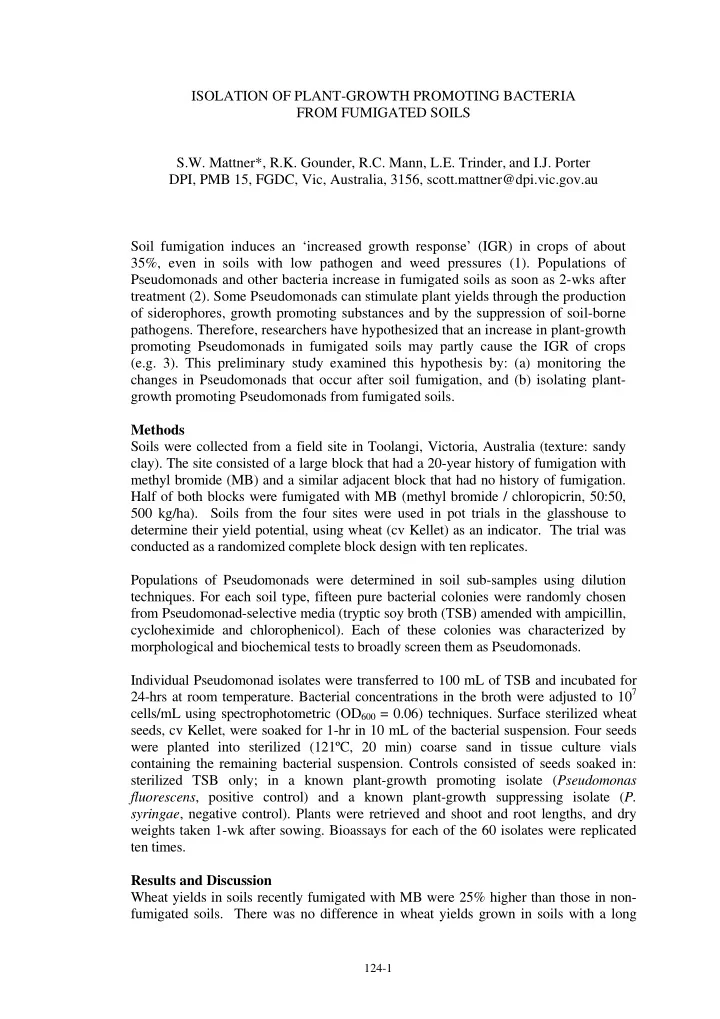

ISOLATION OF PLANT-GROWTH PROMOTING BACTERIA FROM FUMIGATED SOILS S.W. Mattner*, R.K. Gounder, R.C. Mann, L.E. Trinder, and I.J. Porter DPI, PMB 15, FGDC, Vic, Australia, 3156, scott.mattner@dpi.vic.gov.au Soil fumigation induces an ‘increased growth response’ (IGR) in crops of about 35%, even in soils with low pathogen and weed pressures (1). Populations of Pseudomonads and other bacteria increase in fumigated soils as soon as 2-wks after treatment (2). Some Pseudomonads can stimulate plant yields through the production of siderophores, growth promoting substances and by the suppression of soil-borne pathogens. Therefore, researchers have hypothesized that an increase in plant-growth promoting Pseudomonads in fumigated soils may partly cause the IGR of crops (e.g. 3). This preliminary study examined this hypothesis by: (a) monitoring the changes in Pseudomonads that occur after soil fumigation, and (b) isolating plant- growth promoting Pseudomonads from fumigated soils. Methods Soils were collected from a field site in Toolangi, Victoria, Australia (texture: sandy clay). The site consisted of a large block that had a 20-year history of fumigation with methyl bromide (MB) and a similar adjacent block that had no history of fumigation. Half of both blocks were fumigated with MB (methyl bromide / chloropicrin, 50:50, 500 kg/ha). Soils from the four sites were used in pot trials in the glasshouse to determine their yield potential, using wheat (cv Kellet) as an indicator. The trial was conducted as a randomized complete block design with ten replicates. Populations of Pseudomonads were determined in soil sub-samples using dilution techniques. For each soil type, fifteen pure bacterial colonies were randomly chosen from Pseudomonad-selective media (tryptic soy broth (TSB) amended with ampicillin, cycloheximide and chlorophenicol). Each of these colonies was characterized by morphological and biochemical tests to broadly screen them as Pseudomonads. Individual Pseudomonad isolates were transferred to 100 mL of TSB and incubated for 24-hrs at room temperature. Bacterial concentrations in the broth were adjusted to 10 7 cells/mL using spectrophotometric (OD 600 = 0.06) techniques. Surface sterilized wheat seeds, cv Kellet, were soaked for 1-hr in 10 mL of the bacterial suspension. Four seeds were planted into sterilized (121ºC, 20 min) coarse sand in tissue culture vials containing the remaining bacterial suspension. Controls consisted of seeds soaked in: sterilized TSB only; in a known plant-growth promoting isolate ( Pseudomonas fluorescens , positive control) and a known plant-growth suppressing isolate ( P. syringae , negative control). Plants were retrieved and shoot and root lengths, and dry weights taken 1-wk after sowing. Bioassays for each of the 60 isolates were replicated ten times. Results and Discussion Wheat yields in soils recently fumigated with MB were 25% higher than those in non- fumigated soils. There was no difference in wheat yields grown in soils with a long 124-1
history of fumigation and no history of fumigation. By 4-wks, MB-fumigated soils had higher populations of Pseudomonads (increased by c. 10-fold) than non-fumigated soils, and this effect was consistent across soils with different fumigation histories. Of the 60 Pseudomonad isolates tested, 14 were plant-growth promoters, 6 were plant-growth suppressors and 40 were plant-growth neutral (Figure 1). For example, an isolate identified by fatty acid methyl ester analysis as P. fluorescens biotype B (similarity index, 0.822), increased the root growth of wheat by 130%. In contrast, an isolate identified as P. putida biotype A (SI, 0.836), reduced root growth by 70%. On average, the Psuedomonad isolates had a neutral effect on the growth of wheat. Neither history of soil fumigation nor fumigation itself affected the proportion of growth-promoting Pseudomonads isolated from soils or the degree to which they promoted growth. It could be hypothesized that Pseudomonads contribute to the IGR because their total populations in fumigated soils increase, and therefore the total populations of growth promoting Pseudomonads would also increase. However, our early trials show that small differences in inoculum concentration (10 5 cells/mL and 10 7 cells/mL) do not affect the degree of plant growth promotion by the P. fluorescens isolated in this trial. Therefore, although sample sizes were small, evidence from this preliminary trial does not currently support the hypothesis that changes in Pseudomonad populations following fumigation alone cause the IGR of crops in fumigated soils. Past difficulties with the in-field implementation of biological controls suggest that it is unlikely that a single group of organisms would cause the IGR. Alternatively, we propose that the IGR is caused by the complex of changes that occur in soil chemistry (eg soil N (2)) and biology (eg increases in populations of nitrifiers) following fumigation, and their possible interaction with the soil environment. It seems likely, however, that Pseudomonads play an important role in these interactions. Future research needs to investigate the interaction between biological and chemical factors in causing the IGR. References 1. Porter, I.J. et al. (2006). Validating the yield performance of alternatives to methyl bromide for pre-plant fumigation. UNEP, Nairobi, Kenya. 2. Brett, R.W. et al. (2001). Microflora and nutrient changes after fumigation. Proceedings of the 2 nd Australasian Soilborne Disease Symposium, Lorne, Vic., Australia, pp. 93-94. 3. Frommel, M.I. (1991). Growth enhancement and developmental modification of in vitro grown potato as affected by a non-fluorescent Pseudomonas sp. Plant Physiology 96: 928-936. 124-2
Figure 1. Root lengths (above the control) of wheat inoculated with Pseudomonad isolates (36 of the 60 isolates tested) from fumigated and non-fumigated soils. ‘Neg’ is the negative control (known growth suppressing isolate, P. syringae ) and ‘Pos’ is the positive control (known growth promoting isolate, P. fluorescens ). 124-3
Recommend
More recommend